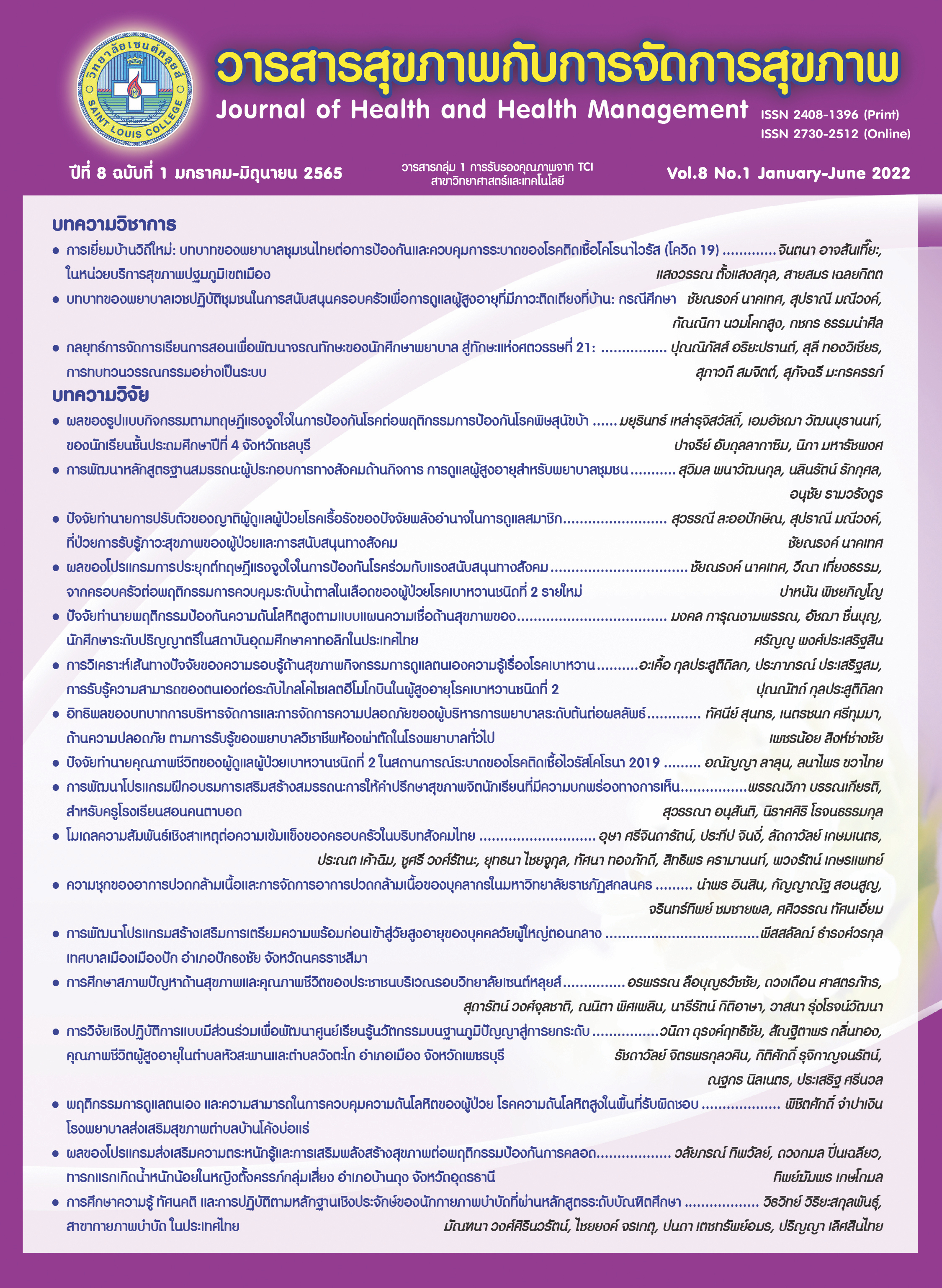Factors Predicting Quality of Life in caregivers of Type 2 Diabetes patients During the Coronavirus 2019 Pandemic
Keywords:
caregivers of type 2 Diabetes Patients, Quality of Life, Coronavirus 2019 PandemicAbstract
The purpose of this descriptive research was to study the level of quality of life, factors related to the quality of life, and factors predicting quality of life in caregivers of type 2 diabetes mellitus patients during the Coronavirus 2019 pandemic. The participations were 145 caregivers of type 2 diabetes mellitus patients who were conveniently selected. Research tools were questionnaires that included the demographic data, Suanprung Hospital’s stress assessment form, stress coping scale, social support questionnaire, and the qualityoflife questionnaire. The content validity index of a questionnaire was 0.86. The reliability coefficients of each sub-parts were 0.89, 0.88, 0.76, 0.86, and 0.82, respectively. For data analysis, descriptive statistics and multiple regression were analyzed. The results demonstrated that the overall quality of life in caregivers of type 2 diabetes mellitus patients during the Coronavirus 2019 pandemic was moderate level ( = 86.42, S.D. = 17.90). When considering each aspect, it revealed that the quality of life in the environment was at a good level (
= 33.68, S.D. = 8.62). The quality of life for physical health (
= 23.03, S.D. = 4.45), psychological quality of life (
= 20.35, S.D. = 4.02), and quality of life social relationships (
= 9.35, S.D. = 2.87) was moderate. Moreover, the most factors influencing the quality of life in caregivers of type 2 diabetes patients were social support and coping with stress (P < 0.01).
References
กรมสุขภาพจิต. (2563). องค์ความรู้การดูแลสุขภาพใจในสถานการณ์การระบาดโควิด-19 “ใจพร้อม ไม่ยอมป่วย”. นนทบุรี: กรมสุขภาพจิต กระทรวงสาธารณสุข.
กรมสุขภาพจิต กระทรวงสาธารณสุข. (2563). แบบประเมินความเครียด กรมสุขภาพจิต. สืบค้นเมื่อ1 กันยายน 2563, จาก https://www.dmh.go.th/test/Download/
กรมสุขภาพจิตกระทรวงสาธารณสุข. (2563). เครื่องชี้วัดคุณภาพชีวิตขององค์การอนามัยโลกชุดย่อ ฉบับภาษาไทย. สืบค้นจาก https://www.dmh.go.th/test/Download/
กีรติญา ไทยอู่. (2558). ความเครียดและการเผชิญความเครียดของผู้ดูแลผู้สูงอายุโรคจิตเวช.กรุงเทพมหานคร: กรมควบคุมโรค กระทรวงสาธารณสุข.
กังวานไทย ออกตลาด. (2560). ศักยภาพและคุณภาพชีวิตของผู้ดูแลผู้ป่วยกลุ่มติดเตียงโรงพยาบาลห้วยเกิ้งจังหวัดอุดรธานี. วารสารการแพทย์โรงพยาบาลอุดรธานี, 25(3), 231-240.
จิรนันท์ ปุริมาตย์, โชคชัย หมั่นแสวงทรัพย์, ศุภชัยปิติกุลตัง, และกรวรรณ ยอดไม้. (2562). ปัจจัยที่มีอิทธิพลต่อคุณภาพชีวิตของผู้ดูแลผู้สูงอายุที่มีภาวะพึ่งพิง ในจังหวัดจันทบุรี. วารสารวิชาการสาธารณสุข, 28(4):610-619.
ดลฤดี ทับทิม, อังศินันท์ อินทรกำแหง, และอรพินทร์ ชูชม. (2563). ความเข้มแข็งทางใจของญาติผู้ดูแล:สิ่งสำคัญในการดูแลผู้สูงอายุโรคเบาหวาน.วารสารสังคมศาสตร์และมานุษยวิทยาเชิงพุทธ, 6(1):1-16.
ธีระพงษ์ ทศวัฒน์ และปิยะกมล มหิวรรณ. (2563). การพัฒนาคุณภาพชีวิตทางสังคมของประชาชนและการป้องกันการแพร่ระบาดของโรคติดเชื้อไวรัสโคโรนา 2029 (COVID-19). วารสารมหาจุฬานาครทรรศน์. 7(9), 40-55.
ธีรศักดิ์ พาจันทร์, กฤชกันทร สุวรรณพันธุ์, บุญสันอนารัตน์ และนิรันทร์ ถาละคร. (2565). ปัจจัยที่มีความสัมพันธ์กับการควบคุมระดับน้ำตาลในเลือดของผู้ป่วยเบาหวานชนิดที่ 2 อำเภอท่าบ่อ จังหวัดหนองคาย. วารสารศูนย์อนามัยที่ 9, 16(1), 285-298.
ณัฐพงศ์ เป็นลาภ และธีรยุทธ รุ่งนิรันดร.(2559).ความเครียดและปัจจัยที่เกี่ยวข้องของผู้ดูแลผู้ป่วยโรคไตเรื้อรังณ แผนกอายุรกรรมโรงพยาบาลจุฬาลงกรณ์. จุฬาลงกรณ์เวชสาร, 60(4), 425-438.
ณัฐวรรณ พินิจสุวรรณ์, กนกพร สุคำวัง, และภารดี นานาศิลป์. (2561). ปัจจัยทำนายคุณภาพชีวิตของผู้ดูแลผู้สูงอายุที่มีภาวะสมองเสื่อม. พยาบาลสาร, 45(2), 1-13.
นิพร ขัดตา, ขนิตฐา หาญประสิทธิ์คำ, และอภิญญา ศิริพิยาคุณกิจ. (2561). ความสัมพันธ์ระหว่างปัจจัยคัดสรรภาระการดูแลและคุณภาพชีวิตของญาติผู้ดูแลผู้ที่ได้รับการล้างไตทางช่องท้องอย่างต่อเนื่อง. วารสารวิทยาลัยพยาบาลบรมราชชนนี นครราชสีมา, 24(2), 108-129.
นิพิฐพนธ์ สนิทเหลือ, วัชรีพร สาตร์เพ็ชร, และญาดา นภาอารักษ์. (2562). การคำนวณขนาดตัวอย่างด้วยโปรแกรมสำเร็จรูป G*POWER. วารสารวิชาการสถาบันเทคโนโลยีแห่งสุวรรณภูมิ, 5(1), 496-507.
ประคอง กรรณสูตร. (2542). สถิติเพื่อการวิจัยทางพฤติกรรมศาสตร์. พิมพ์ครั้งที่ 3. กรุงเทพฯ; ด่านสุทธราการพิมพ์.
รพีพงค์ ยังวราสวัสด์ และพรรณวดี สมกิตติกานนท์.(2563). การจัดการความเครียดทางการเงินในช่วงการระบาดของโรคติดเชื้อไวรัสโคโรนา 2019.วารสารสุขภาพกับการจัดการสุขภาพ. 6(1), 1-9.
รวีวรรณ กลิ่นสุวรรณ, นันทิยา วัฒายุ, และนันทวรรณ สุวรรณรูป. (2560). ปัจจัยทำนายคุณภาพชีวิตของผู้ดูแลในครอบครัวผู้ป่วยไตวายเรื้อรังที่ได้รับการล้างไตทางหน้าท้อง.วารสารพยาบาลศาสตร์ จุฬาลงกรณ์มหาวิทยาลัย, 29(1), 25-66.
รัตนา ศิริพานิช. (2535). หลักการสร้างแบบสอบวัดทางจิตวิทยาและทางการศึกษา. กรุงเทพฯ: สาขาจิตวิทยาคณะศิลปะศาสตร์.
เยาวลักษณ์ ทวีกสิกรรม, ปริญดา ศรีธราพิพัฒน์, และมณีรัตน์ พราหมณี. (2557). ปัจจัยที่สัมพันธ์กับคุณภาพชีวิตของผู้ดูแลผู้ป่วยโรคเรื้อรังที่มีภาวะพึ่งพาในเขตอำเภอมโนรมย์ จังหวัดชัยนาท. วารสารพยาบาลกระทรวงสาธารณสุข. 23(2), 104-108.
อณัญญา ลาลุน และบษพร วิรุณพันธ์. (2564). ผลของโปรแกรมการจัดการตนเองต่อระดับน้ำตาลสะสมในเลือดและคุณภาพชีวิตผู้ป่วยโรคเบาหวานชนิดที่ 2 ในเขตรับผิดชอบโรงพยาบาลแก้งคร้อ จังหวัดชัยภูมิ. ราชาวดีสาร วิทยาลัยพยาบาลบรมราชชนนีสุรินทร์. 11(1), 66-80.
อรพินท์ สีขาว. (2559). การจัดการโรคเบาหวาน (พิมพ์ครั้งที่ 3). กรุงเทพฯ: ห้างหุ้นส่วนจําากัด เอ็ม แอนด์ เอ็ม เลเซอร์พริ้นต์.
Arnold, S. V., Khunti, K., Tang, F., Chen, H., Nicolucci, A., Gomes, M. B., ... & DISCOVER investigators. (2021). Impact of micro-and macrovascular complications of type 2 diabetes on quality of life: Insights from the DISCOVER prospective cohort study. Endocrinology, Diabetes & Metabolism, https://doi.org/10.1002/edm2.321
Chami, M. A., & Khaled, M. B. (2022). Epidemiology, diagnosis, and assessment of diabetes mellitus in the elderly population: a purposive review. The North African Journal of Food and Nutrition Research, 6(13), 9-21. https://doi.org/10.51745/najfnr.6.13.9-21
WHOQOL Group. (1996). WHO QOL-BREF Introduction, Administration, Scoring and Generie Version of the Assessment. Retrieved June 1, 2020 from. https://apps.who.int/iris/bitstream/handle/10665/63529/WHOQOL-BREF.pdf?sequence=1
Ogurtsova, K., Guariguata, L., Barengo, N. C., Ruiz, P. L. D., Sacre, J. W., Karuranga, S., ... & Magliano, D. J. (2022). IDF diabetes Atlas: Global estimates of undiagnosed diabetes in adults for 2021. Diabetes research and clinical practice, 183, https://doi.org/10.1016/j.diabres.2021.109118.
Malik, A.J., Ahmed, S., Shinde, M., Almermesh, S.H.M, Alghamdi, S,. Hussain, A,.& Anwar, S. (2022).The Impact of COVID-19 On Comorbidities: a Review Of Recent Updates For Combating It., Saudi Journal of Biological Sciences 29, 3586-3599. https://doi.org/10.1016/j.sjbs.2022.02.006
Downloads
Published
How to Cite
Issue
Section
License
Copyright (c) 2022 Journal of health and health management

This work is licensed under a Creative Commons Attribution-NonCommercial-NoDerivatives 4.0 International License.




